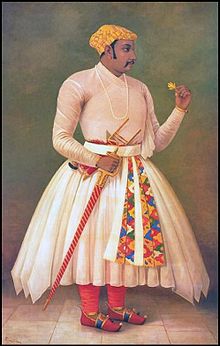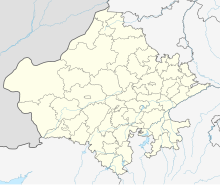Prince Salim's Invasion of Mewar
| Prince Salim's Invasion of Mewar | |||||||||
|---|---|---|---|---|---|---|---|---|---|
| Part of Mughal conquest of Mewar | |||||||||
| |||||||||
| Belligerents | |||||||||
|
|
| ||||||||
| Commanders and leaders | |||||||||
|
|
| ||||||||
Location within Rajasthan | |||||||||
The Prince Salim's Invasion of Mewar was a military expedition of the Mughal empire towards the Rajputs of Mewar. After the invasion by Jagannath Kachwaha in 1585, the Mughal Empire did not launch any major expeditions to Mewar until Maharana Pratap's death in 1597 A.D. From 1585 until his death, Maharana Pratap didn't face any invasions from the Mughals as the Emperor Akbar was preoccupied with internal matters and expeditions to Afghanistan. Following Maharana Pratap's death in 1597 A.D., his son Amar Singh assumed his father's mantle over certain areas of Mewar. A new expedition, led by the then Prince Salim, also known as Prince Salim, accompanied by Man Singh, was launched with the objective of weakening the power of Mewar.[7] This attempt took place in 1599 A.D. or in 1600 A.D.[8]
The Kingdom of Mewar was one of the few kingdoms that had resisted the expansion of the Mughal Empire in India. They fought numerous battles to prevent the Mughals from gaining control over their territory. Amar Singh, the successor of Maharana Pratap, is particularly known for his heroic resistance to the Mughals during Jahangir's reign. However, the Kingdom of Mewar eventually submitted to the Mughals after Mughal conquest of Mewar in 1617 A.D. This marked the end of their resistance and the Mughals were able to establish control over the region.
Background[edit]


During Maharana Pratap's reign, the kingdom of Mewar faced significant adversity under the rule of the Mughals.[9] However, from 1585 until his death, Pratap enjoyed a peaceful rule in his small area of western Mewar.[10][11] After Pratap's death in 1597, his son was crowned as the ruler of Mewar. Amar Singh continued his father's fight for independence.[11] The Mughals took the offensive again, and in 1599 Akbar sent Prince Salim and Raja Man Singh to invade Mewar.[9][12][13]
The Campaign[edit]
The Prince frittered away his time in the pursuit of pleasure at Ajmer, but the valiant Raja aided by other officers did a great deal. Amar Singh led the attack, but he was defeated, and his country was devastated by the imperialists.[14][15] The campaign came to an end abruptly, when Raja Man Singh was called away by the Emperor in order to quell the revolt of Usman Khan in Bengal.[16] A momentous event unfolded in Mewar when the Mughals orchestrated a devastating defeat against Rana Amar Singh, prompting his retreat to the rugged terrain. Despite Prince Salim's exhaustive efforts to locate him in the hilly regions of Mewar, Amar Singh remained elusive. Following the defeat, Mewar endured extensive looting, and the Mughals strategically positioned their outposts in pivotal areas that had previously been under Rana's jurisdiction.[11] This event marked a significant turning point, solidifying Mughal dominance while diminishing the authority of the Rajputs in the region.The repeated invasions in Mewar led to a depletion of its resources and weakened the resolve of Rana.[17][11] Until the death of Pratap, the emperor was preoccupied with domestic affairs. Following Pratap's death, a military expedition led by Prince Salim, and accompanied by Man Singh, was dispatched.[11][17] This expedition was aimed at Mewar to quash the authority of Rana Amar Singh.[17][11] The invasion resulted in a decisive defeat for Pratap's successor[18] and the Man Singh invested the country of Mewar.[11][19]


Aftermath[edit]
Following the defeat in the expedition, the authority of the Rana of Mewar was significantly weakened, resulting in the loss of a number of crucial outposts to the Mughals.[11] Among these were pivotal Mewar outposts such as Ontala, Mandal, Mohi, and Bagore, all of which were subsequently annexed by the Mughals as part of their expanding territories.[20][10][11][21]
See also[edit]
References[edit]
- ^ Singh, Surender (2008). Popular Literature and Pre-Modern Societies In South Asia. Pearson India. p. 68. ISBN 9789332509818.
Prince Salim in the conquest of Mewar and inflicted defeat on Rana Amar Singh. When he became the Mughal emperor, Jahangir gave a red patent for Fatehpur to Alaf Khan
- ^ Bhagi, M.L. (1965). Medieval India, Culture and Thought. Indian Publications. p. 45.
The Mughals led by Prince Salim and Raja Man Singh invaded Mewar and Amar wasdefeated.
- ^ Mahajan, V. D. (2007). History of Medieval India. S. Chand Publishing. p. 81. ISBN 978-81-219-0364-6.
The latter took the offensive once again in 1599 and Raja Man Singh and Prince Salim were sent to invade Mewar. Amar Singh was defeated and his country was devastated by the Mughal troops
- ^ Majumdar, Ramesh Chandra (1951). The History and Culture of the Indian People: The Mughal empire. G. Allen 8 Unwin. p. 133.
In 1600 Akbar made another attempt against Mewar when the expedition led by Prince Salim and Raja Man Singh defeated Pratap's successor, Amar Singh, and devastated the country
- ^ Singh, Surender (2008). Popular Literature and Pre-Modern Societies In South Asia. Pearson India. p. 68. ISBN 9789332509818.
- ^ Bhagi, M.L. (1965). Medieval India, Culture and Thought. Indian Publications. p. 45.
- ^ Rajasthan (India) (1962). Rajasthan District Gazetteers. Printed at Government Central Press. p. 37.
- ^ Mehta, Jl. Advanced Study in the History of Medieval India. Sterling Publishers Pvt. Ltd. p. 246. ISBN 978-81-207-1015-3.
- ^ a b Mahajan, Vidya Dhar (1967). India Since 1526. S. Chand. p. 71.
- ^ a b Sharma, G. N. (1954). Mewar and the mughal emperors. pp. 124–125.
- ^ a b c d e f g h i Srivastava, lal Ashirbadi (1957). Akbar The Great Vol 1. pp. 462–464.
- ^ Awan, Muhammad Tariq (1994). History of India and Pakistan: pt. 1. Great Mughals. Ferozsons. p. 194. ISBN 978-969-0-10035-1.
- ^ Sharma, Shripad Rama (2003). The Crescent in India: A Study in Medieval History. Bharatiya Kala Prakashan. pp. 407/485. ISBN 978-81-8090-028-0.
- ^ Mahajan, V. D. (2007). History of Medieval India. S. Chand Publishing. p. 81. ISBN 978-81-219-0364-6.
- ^ Bhagi, M. L. (1965). Medieval India, Culture and Thought. Indian Publications. p. 45.
- ^ DHAR, TRILOKI NATH; Dhar, Raj Shree (2014-01-01). THE BATTERED HINDU: History of India from 712 A.D. to 1947 A.D. Mohini publications. p. 113.
- ^ a b c Majumdar R.c. (1974). The Mughul Empire. p. 132.
- ^ Mahajan, Vidya Dhar (1965). Muslim Rule in India. S. Chand. p. 83.
- ^ Awan, Muhammad Tariq (1994). History of India and Pakistan: pt. 1. Great Mughals. Ferozsons. p. 194. ISBN 978-969-0-10035-1.
- ^ Prasad, Beni (1940). History of Jahangir. Indian Press, Limited. p. 193.
- ^ Rajasthan (India) (1975). Rajasthan [district Gazetteers].: Alwar. Printed at Government Central Press. p. 34.



